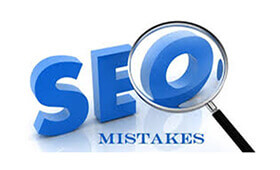
SEO Success Pyramid
February 15, 2016
4 Honest SEO Mistakes Part 2
February 19, 2016
No one gets a site penalty on purpose. Sometimes it happens through carelessness, sometimes, through honest SEO mistakes.
I’ve watched four such mistakes happen recently. These sites were honestly attempting to follow SEO best practices, but they were penalized. Why? I’ll explain all in two parts of my articles.
It is worth because it is a real-life experience, not a theory. Each point that I discuss below is tied to a real life ranking problem.
- Link-Leveraged Business Relationships
The problem explained: Many businesses create relationships with other businesses. As a way of cementing the relationship, the businesses offer to create links to one another in order to enhance SEO and click-through traffic.
Sometimes, however, these good intentions — trading links — end up hurting one or both of the sites.
Obviously, the sites got a ton of links as a result of this footer link — 16 million, to be exact. Every page of AM Store’s website included a direct link to the homepage of FaithCard.
This became highly problematic. Soon after the footer link was added, FaithCard got hit with a manual penalty.
Investigating the link profile, it was obvious that FaithCard had a highly suspicious link velocity ( a back link rate at which inbound links are acquired), a disproportionately high number of links from a single site, and link positioning in the footer.
The problem with FaithCard was compounded by the fact that they had quite a few other backlinks. The footer link buildup from AM Stores, however, was the last straw. Footer links are notoriously slippery for SEO. Their impact ranges from negligible to dangerous.
This issue could have been worsened if the two sites had swapped links — that is, if this site linked to AM Stores, and AM Stores linked to the site in a reciprocal way. Reciprocal linking is a shady area and needs to be entered into with extreme caution — i.e., as naturally as possible. No footer link swaps.
Solution: In this case, the solution would be to have the partner site remove the footer link to FaithCard. Obviously, FaithCard will now have to deal with the fallout of the penalty, but one of the best ways to swiftly and conclusively deal with it is to have an actual link removal rather than a simple domain disavowal.
- Affiliate Programs
Affiliate linking can either help SEO or it can damage it. It all depends on how you implement it.
It’s true, and it leaves many SEOs scratching their heads to how exactly to deal with affiliate links.
The Problem: Online affiliate relationships are big business. For the most part, they’re spam free. Companies can engage in affiliate relationships without fear of penalization.
But if a company goes into affiliate linking, they can get bit.
The safest way to conduct affiliate linking is through the following methods:
- Use a trusted affiliate relationship provider to conduct 100% of the affiliate program rollout. This option is best if you or your development team do not have the skill or experience required to create an affiliate program from scratch.
- Create a dedicated landing page for large affiliate providers. If you have relationships with major organizations, go ahead and created a dedicated landing page for them specifically. This helps them while also protecting your site.
- Test all affiliate links from time to time. To maintain site integrity, it’s best to go through each affiliate link and make sure it’s functioning properly. If you find any broken links, be sure to create a permanent redirect.




